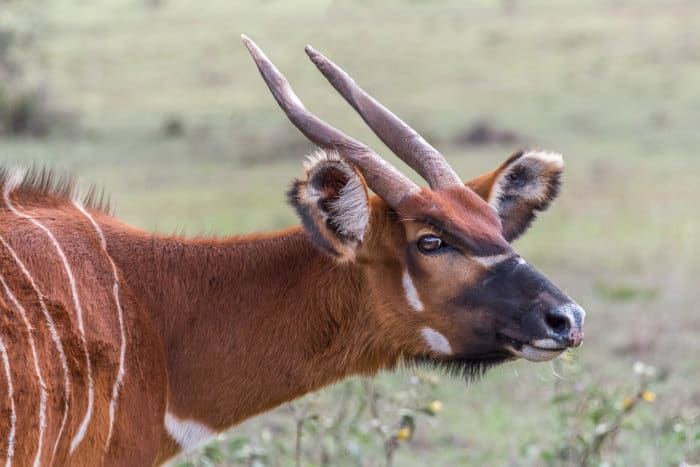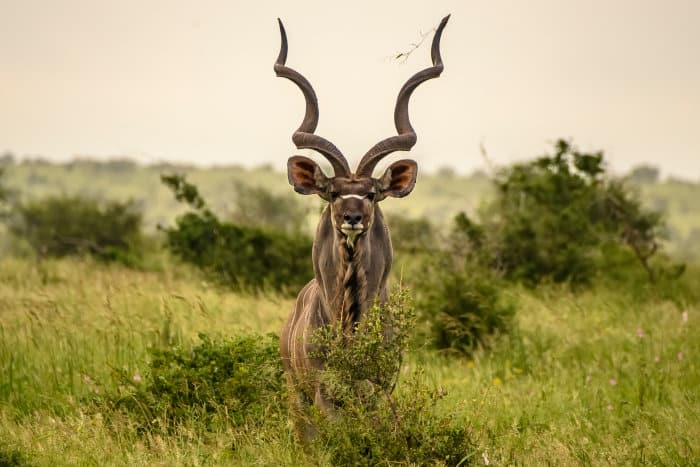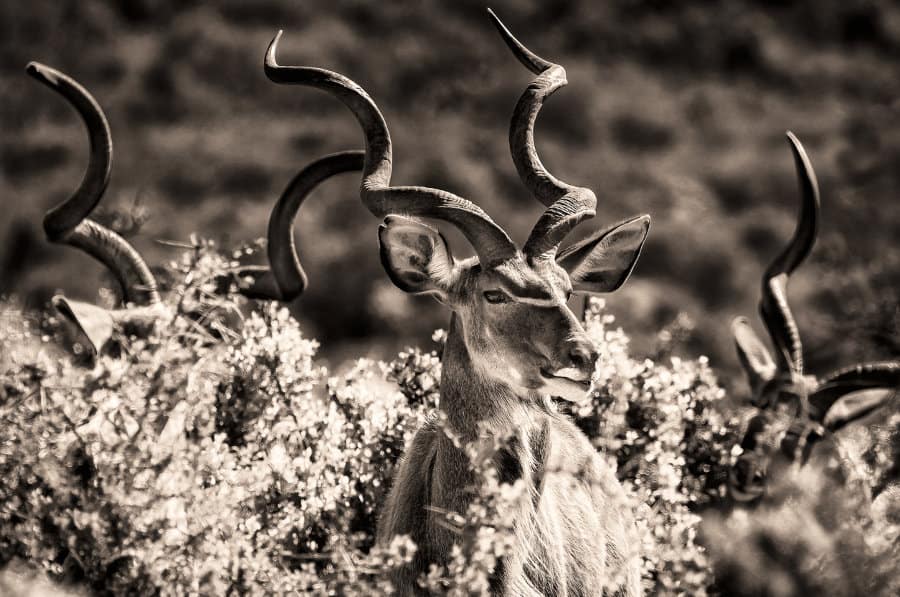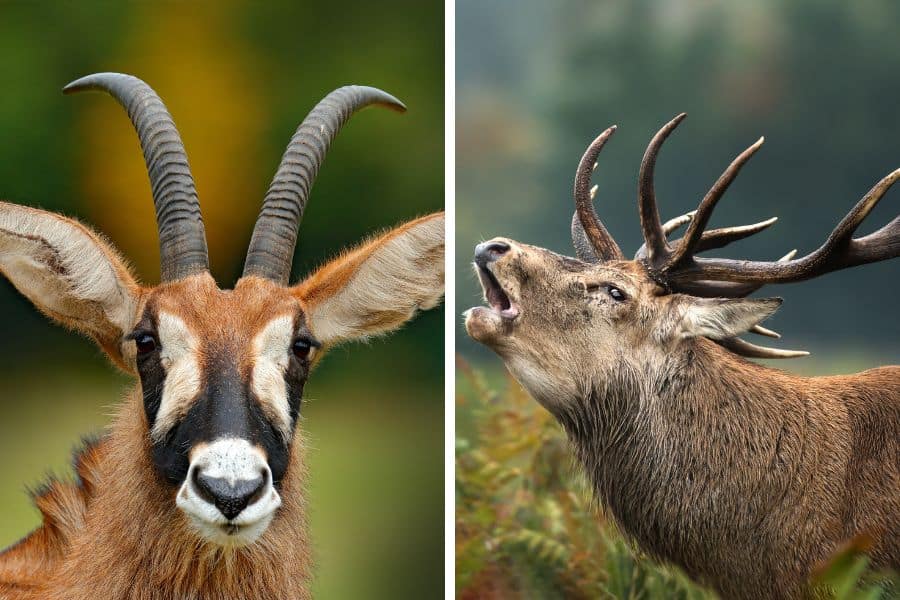Africa is full of massive mammals, from enormous elephants to huge hippos and rotund rhinos.
Besides these familiar faces, most of the top 10 largest antelope species in the world also live on the continent.
African antelope are a diverse bunch, with a lot more variation than you might expect.
Many people think of slender and graceful gazelles leaping across the grassland, but did you know the biggest antelope species weighs over a tonne?
While most of the world’s largest antelope live in Africa, it doesn’t have a monopoly on bulky bovids.
Asia’s largest antelope, the nilgai, cracks the top 10. Above and below it on the list are a range of stunning antelope species with colourful coats, distinctive horns, and impressive adaptations.
Below are the top 10 largest antelope species in the world, ranked by weight. Read on to see which species made the cut and learn more about these magnificent animals.
1. Giant Eland: The Largest Antelope Species in the World

Taking the crown of ‘world’s largest antelope species‘ is the aptly named giant eland.
This spiral-horned species stands 1.8 metres tall at the shoulder, with a body length of up to 2.9 metres. Most impressively, the largest males can tip the scales at up to a tonne, or 1000 kg.
With its heavily muscled physique and distinctive horns – which can grow to over a metre long – the giant eland is an intimidating sight. It’s fast, too, with a top speed of 70 km/h!
Unfortunately, it’s not that easy to see them in the wild. Giant eland are classified as vulnerable on the IUCN Red List, and the two subspecies are restricted to small portions of Western and Central Africa.
2. Common Eland

The second-largest antelope in the world is the giant eland’s close relative, the common eland.
While it may not be giant in name, this enormous antelope isn’t much smaller than the other eland species. There’s plenty of overlap in size, and males can weigh over 900 kg.
This African antelope is relatively widespread, inhabiting a range of habitats in Eastern and Southern Africa. They often live in large herds numbering in the hundreds.
Common eland also have spiral horns, although unusually, females’ horns are longer than males’.
As the slowest antelope species, common eland are vulnerable to apex predators, but adults’ large size is usually a deterrent.
3. Bongo

The world’s third-largest antelope is the bongo. It’s nowhere near the size of the two largest antelope species, but males can still reach a hefty 400 kg.
The bongo has two subspecies. Western or lowland bongos live in tropical jungles in Central and Western Africa, while eastern or mountain bongos are only found in a few mountainous parts of Kenya.
Bongos are often considered one of the most beautiful antelope species, with a vibrant reddish-brown coat and white stripes. These markings double up as effective camouflage in its dense forest habitat.
With its nocturnal nature and small, declining population, this elegant African antelope is rarely seen.
4. Greater Kudu

The regal greater kudu stands tall at number 4 on the list.
The magnificent males are unmistakeable, with huge, twisted horns adding to their already impressive height of around 1.6 metres at the shoulder. That makes them one of the tallest antelope species.
Greater kudu have colourful coats of reddish brown to blue-grey, coupled with a set of vertical white stripes running down their flanks. Long legs and a proud posture make this beautiful bovid stand out on safari.
Greater kudu bulls usually weigh up to 270 kg but occasionally exceed 310 kg. Cows, however, are hornless, and much smaller than males.
The greater kudu mainly lives in Eastern and Southern Africa, preferring mixed scrub woodlands for shelter and feeding.
5. Roan Antelope

The roan antelope (named after its reddish-brown coat colour) is the fifth-largest antelope species in the world, though it gives the kudu a run for its money.
With its chestnut coat, muscular body, and clown-like black and white facial mask, the roan is a striking sight as it roams the African savanna. It also boasts ringed, backwards-curving horns and a mane on the back of its neck.
Roan antelope bulls are perhaps slightly smaller than male greater kudu, with the largest reaching around 300 kg. There’s not so much difference between the sexes, though, and roan cows can weigh up to 280 kg.
Roan antelope live in grasslands, savannas, and woodlands of West, Central, and Southern Africa. They generally graze on grass but will sometimes ‘branch out’ to snacking on shrubs.
6. Blue Wildebeest

The blue wildebeest, or brindled gnu, is the larger of the two wildebeest (meaning “wild beast”) species. Males can reach up to 290 kg.
It’s also one of the more unusual looking of the world’s largest antelope species – that’s a kind way of saying it isn’t the most attractive animal on this list.
A long face, dark muzzle, and front-heavy build make this African antelope unmistakable. Despite the name, they’re not exactly blue, though their coats may have a bluish sheen.
Blue wildebeest are famous for taking part in the great migration, where they gather in huge numbers on the grasslands of Tanzania and Kenya, following the rains to greener pastures.
Predators naturally want a piece of this blue wildebeest buffet, but with a top speed of 80 km/h, the third-fastest antelope in Africa can outpace many attackers.
7. Nilgai

The nilgai is the largest antelope in Asia. It’s also the only member of the top 10 largest antelope species in the world that lives outside Africa.
The nilgai’s name translates to “blue cow”, and this sturdily built species certainly resembles a cow more than some of its smaller antelope relatives.
Males have a short pair of horns and a small head that looks a little out of place perched on top of a bulky body.
Nilgai are a common sight in scrub forests and grassy plains in Northern India, with smaller populations in Pakistan and Nepal.
These Asian antelope often graze on agricultural land, and some farmers consider them pests for raiding and trampling crops.
Nilgai bulls can stand up to 1.5 metres tall at the shoulder and weigh up to 288 kg. Females are considerably smaller, rarely exceeding 200 kg.
8. Sable Antelope

The striking sable antelope slots in at number 8.
Sable bulls boast magnificent, curved horns that can reach 1.6 metres, with sleek coats that darken and turn to black as they age. Females generally have chestnut, dark brown, or sometimes black fur.
Bulls average around 235 kg, though large individuals may weigh up to 270 kg. Their horns are used for both predator defence and fighting over mates, but also make them a target for trophy hunters.
Sable antelope live in wooded savannas and grasslands in East and Southern Africa, from Kenya down to South Africa.
The largest subspecies is the giant sable antelope, which is endemic to Angola and the country’s national symbol.
Sadly, this hasn’t stopped the giant sable becoming critically endangered, with just a few hundred individuals left in the wild.
9. Waterbuck

Waterbuck are large antelope, widely distributed in sub-Saharan Africa.
With its shaggy brown coat, the waterbuck isn’t quite as spectacular as some African antelope, although males grow eye-catching spiral horns.
Male waterbuck weigh up to 260 kg. Females are considerably smaller and hornless.
As you might have guessed, waterbuck favour habitat close to water sources, where they can graze away on grasses.
Proximity to the water also comes in handy when fleeing predators – waterbuck will gladly swim away from danger. Yet the most aquatic antelope must be careful it’s not paddling into the jaws of Nile crocodiles.
10. Gemsbok

Hardy and beautiful, the gemsbok rounds out the top 10 largest antelope species in the world. It’s the biggest member of the Oryx genus, with males weighing up to 240 kg.
This stunning species is famed for its straight, spear-like horns that both sexes grow. In a familiar tale, hunters covet these horns as trophies.
The desert-dwelling gemsbok carves out a niche in environments too hostile for many other African species. It lives in arid regions of Southern Africa, such as the Namib and Kalahari deserts.
Gemsbok have many adaptations to arid conditions, mainly focused on conserving water. They don’t sweat, have ultra-concentrated urine, and dry feces.
During droughts, gemsbok glean enough water from their diet of roots, bulbs, grass, and moisture-rich melons and cucumbers.
These versatile feeders can switch from grazing to browsing or dig their dinner out of the dirt.
See the Largest Antelope Species in the World
Except for the nilgai, an African safari is the perfect place to see the top 10 largest antelope species in the world.
Some are much easier to spot than others – common eland might be grazing by the road, while the shy and secretive bongo is far more elusive.
Yet, wherever you go, you’re likely to encounter at least some of these incredible animals.
Keep your eyes peeled and you could also spot an array of amazing antelope that didn’t make this list.



